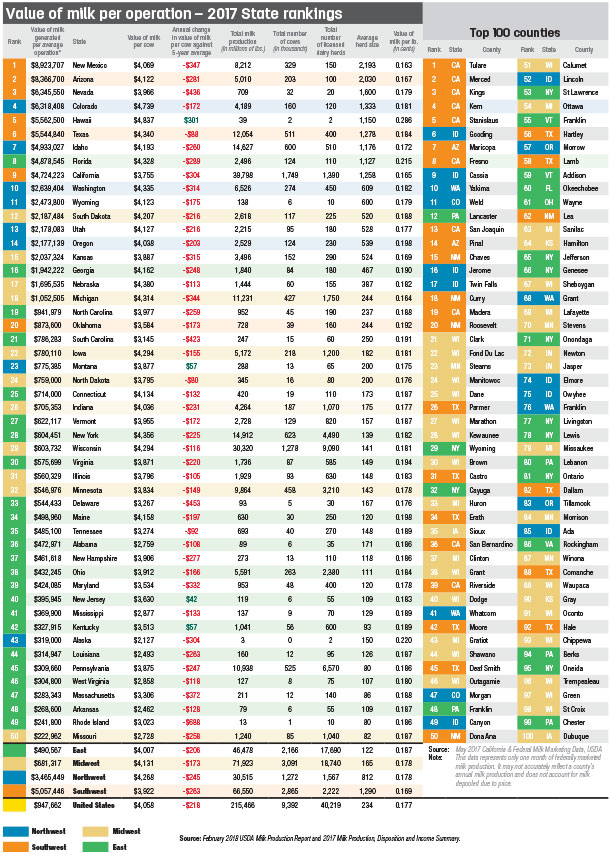For U.S. dairy farmers, 2017 started with lofty financial hopes. By the end of the year, productivity and income were up from 2016, but weakening prices had tempered those expectations.
The USDA’s annual Milk Production, Disposition and Income report, released each April, estimates U.S. cow numbers, milk and milkfat production, volume of milk marketed, prices and cash receipts from milk sales in all 50 states. Progressive Dairyman takes the data a bit further, providing analysis on a per-herd and per-cow basis.
Cow numbers, production up
In 2017, U.S. dairy farmers employed the most cows in about two decades. Cow numbers averaged 9.392 million head for the year, up about 67,000 head from 2016. Milk per cow, at 22,941 pounds, was 163 pounds above 2016. The average milkfat test was 3.84 percent in 2017, up from 3.79 percent in 2016.
Total U.S. milk production increased to 215.5 billion pounds, 1.4 percent more than 2016.
An industry with an impact
Dairy’s economic impact adds billions of dollars to U.S., regional, state and local economies each year. Total 2017 U.S. milk production was valued at $38.1 billion, up from $34.5 billion in 2016.
Marketings (milk sold to plants and directly to consumers) totaled 214.5 billion pounds, about 1.5 percent above 2016. Producer returns averaged $17.69 per hundredweight, 8.3 percent more than 2016. As a result, cash receipts from 2017 milk marketings totaled $37.9 billion, 9.8 percent higher than 2016.
(The USDA estimated about 1 billion pounds of milk were fed to calves or used at home in 2017, with calves fed 91 percent of this milk. Milk used on the farm was valued at $176 million in 2017.)
Among individual agricultural commodities, cash receipts from milk sales ranked fourth in 2017, behind only cattle ($66.5 billion), corn ($46.4 billion) and soybeans ($38.7 billion), according to data from the USDA.
‘$1 billion club’
Eleven states again topped the $1 billion mark for annual milk receipts in 2017. They included (in order) California, Wisconsin, New York, Idaho, Pennsylvania, Texas, Michigan, Minnesota, New Mexico, Washington and Ohio. California and Wisconsin accounted for $12 billion in 2017 cash receipts, or about 32 percent of the U.S. total.
Returns per cow, herd
Progressive Dairyman calculated the value of milk production averaged $4,058 per cow in 2017, $336 more than the year before. However, the average was nearly $1,300 less than the most recent record high of $5,358 per cow returned in 2014 and $218 per cow less than the five-year average.
Click here or on the image above to view it at full size or in a new window.
Excluding Hawaii, the state seeing the highest value in annual milk production per cow in 2017 was Colorado, followed by Nebraska, New York and Texas. Wisconsin ranked 10th, Idaho was 12th, Pennsylvania was 29th, and California was 33rd.
U.S. dairy operations averaged 234 cows in 2017. On a per-herd basis, milk production was valued at $947,662.
With the largest average herd sizes, milk value per operation topped $8 million in New Mexico and Arizona. Among others, Colorado ranked fourth, Texas ranked sixth, Idaho was seventh, and California was ninth. With smaller average herd sizes, New York and Wisconsin ranked 28th and 29th, respectively, with Pennsylvania at 45th.
Outlook for 2018
Prices and income levels are headed lower in 2018. As of late April, the USDA projected range in the all-milk price resulted in a forecasted average of $15.85 per hundredweight. With milk production expected to reach 219 billion pounds, that would yield total milk value of about $34.7 billion (down $3.4 billion from 2017 and about equal with 2016).
The value of milk produced would be about $3,669 per cow (down $389 per cow from 2016 and the lowest since 2010). ![]()








